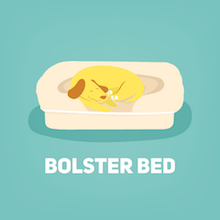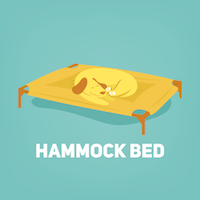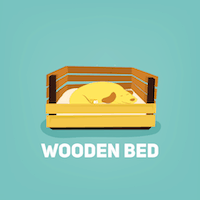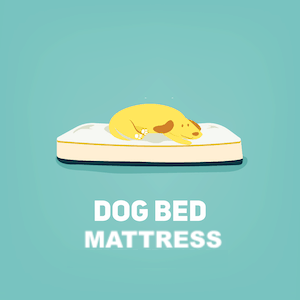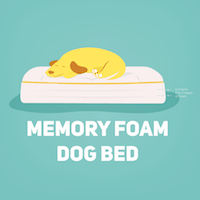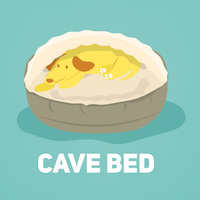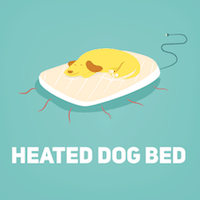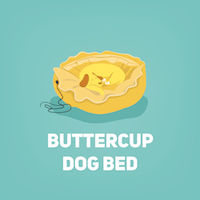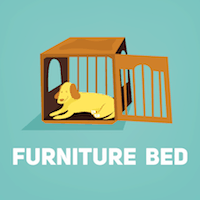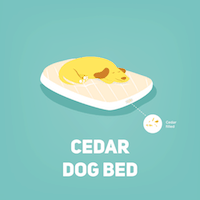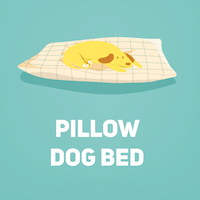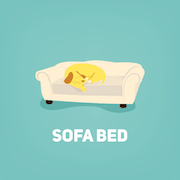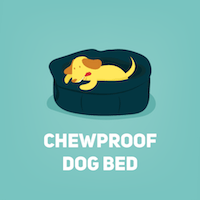Looking to choose the perfect dog bed for your pooch? Our ultimate dog bed guide will teach you all the ins and outs of selecting your perfect dog bed!
What to Consider in a Dog Bed
Picking the best dog bed for your pooch requires that you really understand what your dog, in all his unique snowflake glory, really wants and needs.
How do you do this? Observe your dog like a creepy canine stalker. Take note of his favorite sleeping positions and where he likes to park his behind.
Your dog’s personality and temperament should always be the number one consideration when shopping for a dog bed.
While your personal preferences are important too, purchasing a bed that only needs your needs and not your dog’s will not go over well (you may end up with an glamorous looking bed while your dog continues to sleep on the floor)!
Make sure to consider:
- Roughness. Rougher dogs can make quick work of a delicate wooden dog bed quickly scratching up those find surfaces in minutes. If your dog plays on the rougher side, look for a bed that is durable and can withstand your dog’s demands.
- Activity. If your dog is constantly bouncing around in mud and rain, you’ll likely want a dog bed that is easy to wash.
- Weather. If you live in hot or cool climates, you may want to select a bed to combat the weather. Heated dog beds are great for cool-weather climates, while elevated dog beds provide cooling circulation for hot and humid conditions.
- Temperament. Shy or anxious dogs tend to appreciate beds designed with nesting, burrowing, or cuddling in mind. Consider your dog’s sleep style and disposition.
- Bed Positioning and Location. Are you looking for a dog bed that will take center stage in the middle of your living room? Or will your dog be lounging outdoors for the most part? This will have a considerable impact on the type of bed you shop for.
- Age. Older dogs will likely need thicker, more supportive dog beds to help keep their aching joints comfortable.
- Allergies. If your dog has environmental allergies, you may want to invest in a special hypoallergenic dog bed cover. Some allow you to stuff different filling and see how your dog’s skin responds to the material.
- Size. It goes without saying that you should choose the correct bed for your dog’s size. However, bigger dogs also have unique requirements – like extra padding to keep all that weight off your dog’s joints. It’s also worth remembering that most of the cuter, more stylized dog beds won’t have enough heft to keep extra large dogs happy.
- House Training / Incontinence. If you have a dog that is still being potty trained, or an older dog suffering from incontinence, you’ll want a bed that is easy to wash and won’t keep in moisture. Some beds offer an extra set of outer covers, which is definitely a huge bonus if you plan on tossing your dog bed’s standard outer cover in the wash a lot.
- Removable Covers. Most owners agree – having at least one or two removable covers (as suggested above) will make your life much easier come laundry day. If you suspect even semi-frequent laundering, a dog bed with a removable cover will allow you to avoid washing the entire inner bedding, resulting in a longer-lasting bed. Most dog beds have zippered outer layers that can easily be removed and washed – definitely consider double check for this feature before purchasing a bed.
How Much Should I Spend on a Dog Bed?
Dog beds can range quite a bit in price. The cheapest beds can be purchased for around $30, while the higher end beds designed with several layers of support foam for giant breed canines can cost closer to $300 or even $400.
Obviously your budget will dictate how much you spend on a dog bed. However, dog beds aren’t a great area to cheap out on.
Why? Higher quality dog beds can support your dog’s body and can go a long way to preventing and combating arthritis as your dog ages (which can come with its own host of medical costs and medications). Spending a bit more on a better bed now may mean fewer costly vet visits in the future.
Cheaper dog beds also won’t last as long – they’ll lose their shape more quickly, forcing you to buy a new bed within just a couple of years (if not sooner in some cases).
It’s worth noting that regular adult dogs can usually do just fine with a decent-ish dog bed. However, when your dog gets older or if your dog has unique health issues, a more expensive, higher-quality bed with support and memory foam will go a long way towards your dog’s comfort.
Types of Dog Beds: 16 Kinds to Choose From
Bolster Dog Beds
Also Known As: Raised Edge Dog Beds / Donut Dog Beds / Nesting Beds

Bolster dog beds are beds featuring a raised border edge, which gives the bed a nest-like quality. Bolster beds are made in a variety of sizes and are suited for small and large breed dogs alike.
Bolster, nesting, and donut beds all contain raised edges that help a dog feel more at ease, as well as giving the dog an area to lean on. We grouped all these beds in the same category, but there are some small distinctions – for example, donut beds tend to be very round and have thick, overstuffed rounded borders around the entire edge of the dog bed, while some bolster beds only have one or two raised sides.
Many dogs love resting their head on the bolster bed’s raised edge, using the bolster as a comfortable headrest. If your dog has the habit of resting their head up on a pillow or raised surface, they’ll probably like a bolster bed.
Since bolster beds are rounded, they also tend to be better at retaining heat, making them nice choices for cooler climates.
Bolster beds are ideal for dogs that like to curl up in a circle when they sleep. Nervous or anxious dogs also might enjoy a raised edge dog bed for the added sense of security it provides.
Like the idea of a bolster bed? See our top picks for the Best Bolster Dog Beds!
Memory Foam Dog Beds

Memory foam dog beds are often sought after by owners who want the same comfort for their pooches that they themselves enjoy from memory foam pillows and mattresses.
When discussing memory foam dog beds, it’s worth noting that we are referring to substance rather than design or style. All different styles of beds can be made of memory foam.
It’s also important to understand that the type of memory foam does matter – quite a lot! Some compositions are less impressive than others, and shredded memory foam composites are considerably less desirable than thick slats of whole foam.
Not all beds labeled as “memory foam” are the same – some are made from a ground up fill, while are others are made with thick layers. Cheaper memory foam beds may flatten out quickly, so consider spending a bit more if you do the memory foam route, and ideally look for beds that use entire slabs of memory foam, rather than shredded memory foam fill.
It’s also worth noting that some memory foam beds have a distinct toxic-smelling odor when they’re first opened. Many owners (and dogs too) aren’t too fond of living with such scents. However, airing out the beds for a few days often does the trick and dispels any smells.
The memory foam label alone doesn’t make a solid dog bed – while memory foam is very comfortable, it doesn’t provide much in the way of support. The best dog beds provide a mix of memory foam for comfort on the top layer, and more structural, supportive foam towards the bottom to keep your dog’s joints from hurting and raise him off the ground.
Memory foam beds are best for large and extra-large dogs, as these canines need additional support and padding to keep them comfy and keep their joints properly cushioned from the floor.
Interested in memory foam? See our top picks for the Best Memory Foam Dog Beds!
Buttercup Dog Beds
Also Known As: Daisy Dog Bed / Drawstring Dog Bed

Buttercup dog beds are still a bit of a rarity – you’ll likely only spot them in high-end pet boutiques or on Etsy.
The uniqueness of the buttercup bed lies in the design – it’s quite creative! The bed is composed of a traditional round, flat bed with a toggle drawstring running through it.
When the drawstring is left slack, the bed sits open like a traditional bed. When the drawstring is pulled tighter, the bed changes shape and bunches up into a closed flower bed (or resembling an upside-down mushroom).
This bed is definitely a fun novelty, and it’s kind of cool that the bed doubles as a traditional flat bed as well as a hybrid nesting bed that your dog can burrow and hide in.
The downside is that this design tend to only work well with smaller dogs – buttercup beds just don’t come in sizes big enough to accommodate hefty canines. These beds also won’t work if your dog has a tendency to chew, as the drawstring can be quite tempting for chewers.
Buttercup beds come in all kinds of styles and patterns, partially due to the fact that most are custom ordered from sites like Etsy. These beds also don’t come cheap, although we’d probably rate them as moderately priced in the larger scheme of dog bed price points.
Owners looking for a 2-for-1 dog bed that can serve as a traditional pillow bed as well as a bolster/nesting bed. Also a favorite for anyone who wants a unique-looking bed for their pooch.
Pillow Dog Beds
Also known as: Loose Fill Dog Beds

Pillow dog beds are the most common and basic type of dog bed you’ll come across. They are basically, as their name implies, oversized pillows for your dog to lounge on.
Loose-fill pillow beds are commonly stuffed with polyester fiber fill (especially in cheaper beds), and while this makes these types of beds cheap and affordable, it also means that the material has a tendency to bunch up and break down over time.
You can also find pillow beds stuffed with cotton batting, bean-bag style foam beads, and other materials.
It’s essential that you select a pillow bed with a removable cover, as washing the entire bed will drastically shorten the bed’s lifetime – especially considering the cheaper materials these beds are usually filled with. Or if you don’t mind shopping for a new bed on the regular, removable covers may not be a concern.
One of the major benefits of pillow beds is that they’re everywhere, and they come in all kinds of different shapes, sizes, and style. You’ll find pillow beds with a variety of patterns and colors suited to all sorts of personal preferences.
Many owners choose a pillow bed based on looks, and will then remove fill as it breaks down and switch it out with fresh fill from craft stores to keep the bed full and comfy.
Pillow beds are ideal for owners looking for an affordable, basic, no-frills bed. Also good if you’re looking for a particular pattern or color, as pillow beds tend to come with a wide selection of styles. If possible, opt for higher-quality fill.
Hammock Dog Beds
Also Known As: Mesh Beds / Raised Beds / Elevated Beds

Hammock dog beds are simple, efficient beds that keep your dog suspended off of the ground through the use of tightly woven mesh or fabric.
The fabric is usually wrapped tightly around a metal, wood, or PVC frame.
The elevated surface protects your dog’s body from making contact with the hard ground, helping to keep joints healthy and your dog comfy. The raised bed surface also makes it easier for dogs to get in and out of the bed, providing further joint relief.
Hammock beds made of nylon mesh are also very easy to clean – all they need is a quick spray down. This makes them ideal choices for outdoor use. Due to their ease of cleaning, these beds are especially popular at animal shelters.
Raised dog beds have other benefits too – they allow air to circulate underneath your dog, keeping him cool in the summer.
Some owners like the style of the raised dog beds, but want more cushioning for their canine – in this case, it’s fairly easy to throw a thin mat or blanket over the mesh for added canine comfort.
These beds are especially suited for larger breeds who don’t need much padding, but would still prefer to be kept off of the ground. Great for warm weather climates and for dogs that tend to overheat due to long or thick coats. They’re also nice for messy or incontinent dogs due to the ease of cleaning.
Liking the look of the hammock dog bed? See our top picks for the Best Hammock Dog Beds!
Cave Dog Bed
Also Known As: Burrowing Beds / Hooded Beds

Cave dog beds are the ultimate lounging space for tiny dogs that like to hide and borrow.
Nervous dogs tend to especially love nesting beds, as these beds are designed to provide the warmth, comfort, and security reminiscent of dens that were popular with your pup’s wolf ancestors.
The only pitfall of nesting beds is that they are really only designed for small and toy breeds (usually max size of 20lbs, if even that). There simply aren’t any cave beds on the market to accommodate larger breeds.
Hooded cave beds are great for small dogs that like to burrow and snuggle. Also ideal for hairless or short-haired breeds that tend to get cold easily.
Have a pup that loves to burrow? See our top picks for the Best Cave Dog Beds!
Furniture Dog Beds

Furniture dog beds provide a touch of class to the traditional dog bed. While most dog beds sit in a corner of the home, furniture dog beds let your dog reside right where the action is, without taking up any additional floor space.
Furniture dog beds often use a standard piece of home furniture (most often a coffee table or end table) and allow it to double as a cozy bed for your canine!
Since these beds are designed with décor and style in mind, they may not be as durable as other beds. Often the “furniture bed” term refers more to the shell structure – owners will still be responsible for picking out a crate pad or mattress to place inside the end table or coffee table bed structure.
Since these beds tend to be more delicate, we don’t recommend them for rough dogs or pups especially prone to getting into mischief.
Most of these bed structures are made of wood, which puts them at a higher price point than your standard dog bed.
Furniture beds are great for owners who want a functional dog bed that doesn’t take up extra space and fits in with the home’s decor.
Love the furniture look? See our top picks for the Best Furniture Dog Crates & Beds!
Sofa Dog Beds

Sofa dog beds are in some sense similar to furniture dog beds in that they are designed to emphasize style and design. However, rather than having a piece of human furniture double as a dog bed, this style of canine bedding provides your pooch with their very own sofa to lay about and lounge on.
Sofa beds vary in style and size. Most owners aim to find a sofa dog bed that matches their own home décor (or even matches their existing human sofa).
Some couch dog beds also have storage compartments attached, offering an extra bonus.
The only issue with sofa dog beds is that many aren’t machine washable, due to the high-end, furniture-grade fabric used. This means spot cleaning is usually the only way to go – so not great for messy canines!
While there are a couple sofa dog beds for bigger canines, they tend to be more suited for smaller, petite pooches.
Sofa beds are ideal for owners who want a stylish pet bed that matches their own living room style. Most suitable for small dogs (although there are a few designs for bigger dogs as well).
Can’t get enough of that sofa style? See our top picks for the Best Sofa Dog Beds!
Wooden Dog Beds

Discussion of wooden dog beds usually refers to the framing rather than the bed material itself – even a wooden dog bed will need an inner pad or mattress to provide comfort for your dog.
Most owners who are interested in wooden dog beds are looking for style. These beds often have a more elegant look to them and are easy on the eyes.
Wooden dog beds aren’t as easily to clean as your standard dog bed, and they aren’t recommended for puppies with a propensity for chewing.
Some handy owners even opt for the DIY route and craft their own wooden dog bed!
Owners who want a sleek, sophisticated dog bed frame. Just remember you’ll still need to buy padded bedding for the inside of the frame.
Want that wood look? See our top picks for the Best Wooden Dog Beds!
Heated Dog Beds

Heated dog beds are the perfect thing for owners and canines living in cooler, cold-weather climates. They’re also often used for dogs who spend a lot of time outside in their own dog house dwelling.
Most heated dog beds provide heat by one of two methods:
- Self- generated body heat
- Electricity-powered heat
Dog beds with heating pads that must be plugged in provide plenty of perks with warmth, but owners have the added hassle of worrying about wires and where to plug in the unit. Electric units should definitely be avoided if your dog has a tendency to chew!
Heated dog beds are well-suited for dogs who sleep outdoors in a dog house, or for dogs who reside in colder weather climates.
Is your pup always chilly? See our top picks for the Best Heated Dog Beds!
Waterproof Dog Beds

Waterproof dog beds are usually popular with owners of small puppies still being house-trained or older dogs who have become incontinent.
The definition of “waterproof” tends to vary, as manufacturers handle accident-prone beds a bit differently.
Most are designed with an outer fabric layer made with a zipper cover that can be easily removed and tossed in the machine wash for cleaning, while the inner cushioning or memory foam is protected with a plastic lining to stop any moisture from getting in.
In truth, raised mesh dog beds mentioned earlier can also qualify as waterproof, since urine can’t really permeate the material – it’s just a matter of giving those beds a rinse down.
Regardless of what style of waterproof dog bed you choose, at least some kind of cleaning will definitely be involved when falling victim to accidents.
Waterproof dog beds are a solid choice for accident-prone puppies, incontinent senior dogs, or any dogs that tend to rest at the end of the messy spectrum.
Chew Proof Dog Beds

Chew proof dog beds are designed with tough chewers in mind (we’re looking at you pit bulls). These beds are composed of hyper-durable material, made to withstand even the most merciless chompers.
Materials for chew proof dog beds can vary quite a bit. Cordura, canvas, vinyl, and high denier nylon tend to be popular materials for chew-proof beds.
Also keep an eye out for double stitching and, in some cases, double fabric layers to combat canine chompers. It’s also not a bad idea to opt for beds that come with warranties – in some cases, manufacturers will replace the bed for free if your dog demolishes it.
If your dog normally destroys common canine toys, beds, or crates, then a chew proof bed is an essential.
Do you have a tough chomper? See our top picks for the Best Chew Proof Dog Beds!
Orthopedic Dog Beds
Orthopedic dog beds are designed for optimal comfort and support. Many owners may think they want a memory foam dog bed for their arthritic dog, but really memory foam is just the half of it.
You see, memory foam is great for feeling cozy. It squishes down and forms around you. However, older arthritic dogs actually need some stiff support in their bed as well – a bed that’s nothing but give won’t help them at all!
That’s why orthopedic dog beds often feature a combination of cozy memory foam as well as more structured, heavy duty layers of support foam.
Big Barker is a great example – they make dog beds specifically for large and extra-large canines. Because these giant dogs put more wear and tear on their joints, Big Barker’s seven foam layer combination of memory foam + support foam is essential.
Now remember, Big Barker is great for large dogs, but those seven layers of foam would be way too much for a small dog. However, even older, arthritic small dogs will benefit from an orthopedic dog bed using a combination of memory and support foam. It’s just that Big Barker is – as its name hints at – is made specifically for large canines.
Orthopedic beds are also an excellent choice for thin dogs with prominent bone structures – these dogs require extra cushioning to stop friction between bone and floor.
Owners looking for orthopedic dog beds should seek out beds made with NASA-certified orthopedic foam, which provides excellent support for reducing aches, joint pain, and pressure point stress.
Orthopedic dog beds, with their extra joint support and cushioning, are especially beneficial for large dogs, senior dogs, or very thin dogs.
Do you have a senior dog with joint issues? See our top picks for the Best Orthopedic Dog Beds!
Mattress Dog Beds
Also Known As: Crate Pads / Dog Mattresses
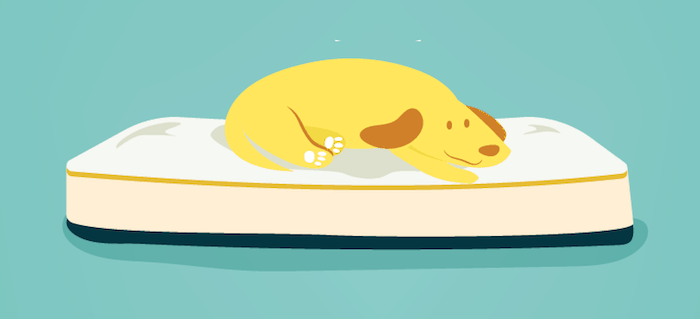
These beds are simple, flat, rectangular shaped beds that are often fitted to match your dog’s crate dimensions.
They tend to resemble smaller human mattress – in fact, some folks use baby crib mattresses for their canines.
They aren’t quite as elegant or flashy as other beds, but they get the job done just fine!
Mattress dog beds are good for owners who are looking for a simple, no-frills style of bed. They’re also great for fitting inside a crate (just make sure the measurements match).
Corner Dog Beds

Corner dog beds are designed to sit in a specific area of your home – in the corner of two walls (or corners made from any other physical structures, such as a couch or table).
Corner dog beds can come in a variety of styles, shapes, and materials.
Corner beds are best when it comes to space saving, making them great choices for apartments or homes that are otherwise short on spare space.
Looking for a bed that fits in a small space? See our top picks for the Best Corner Dog Beds!
Cedar Dog Beds

Cedar dog beds are beds filled with cedar chips, rather than traditional polyfill or memory foam.
The major benefit of cedar dog beds is that they reduce smell – they are ideal for smellier canines with bad odor.
However, it’s worth saying that if you notice a sudden change in your dog’s odor, you should reach out to your vet just in case. Odor is a tool our bodies can sometimes use to indicate something’s up internally, so don’t just ignore your stinky pooch!
The problem with cedar beds is that they aren’t very comfortable and don’t have much in the way of padding or support. Cedar beds also can be an issue for dogs with allergies, so they aren’t the best choice for the sensitive canine.
Cedar beds are a good option for stinky dogs that need a hand eliminating their offending odor.
Dog Bed Sizing
Selecting the perfect dimensions for your doggie
Want the perfect dog bed for you pooch, but not sure what size to get? It all comes down to measurements.
Taking your dog’s measurements is helpful not just for selecting the perfect dog bed, but is also important to have on hand for ensuring that you purchase an appropriately sized collars, life jackets, apparel, or other canine wearables.
Most dog beds are sized by length, but some are also (or instead) sized by weight. Heavier dogs will need thicker, more supportive beds to keep the beds from flattening out and losing shape over time. If beds do specify weight sizing, making sure you adjust for your dog.
HOW TO TAKE YOUR DOG’S MEASUREMENTS
While your dog is napping, go ahead and take his measurements!
If your pooch likes to stretch out, go ahead and measure his full body. If your dog prefers to sleep curled up in a ball, work with those measurements.
Next, add 8-12 inches to your dog’s lying length. Now you have your dog bed measurements!
When in doubt about which size dog bed to order, it’s always advised to round up.
Most manufacturers provide information regarding what size bed you should purchase, depending on your dog’s length.
However, you can’t realize on measurements and size alone to dictate the best bed for your pooch. You’ll want to consider your dog’s preferred style of sleeping too!
Dog Sleeping Styles: How Does Your Dog Snooze?
How does your dog snooze?
Position #1: All Stretched Out (aka Superman)
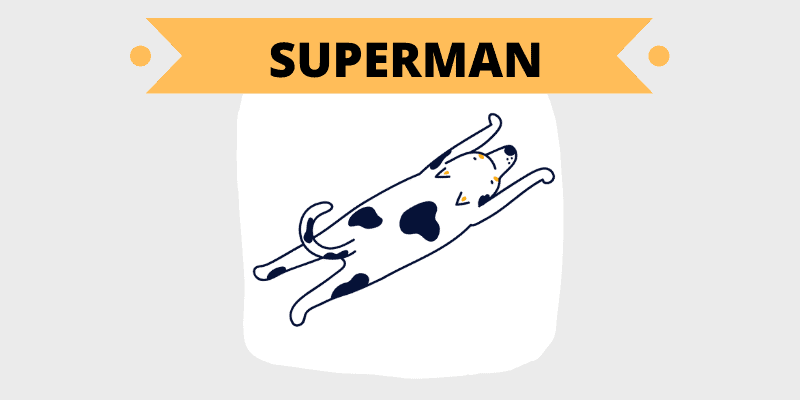
This style defines canines who like to stretch their entire body out when they sleep, from front paws to back. They usually look pretty hilarious sleeping this way, posing superman-style as they snooze.
Stretched out dogs will benefit most from a pillow dog bed, mattress bed, or memory foam bed.
Position #2: Curly & Cozy

This sleep style defines dogs who like to curl up in a tight little ball when they sleep. Many dogs will tuck themselves up so tight that you can barely see a paw or two sticking out.
For dogs that like to curl up, bolster dog beds or cave dog beds (for very small dogs) are your best bet.
Position #3: Belly Up
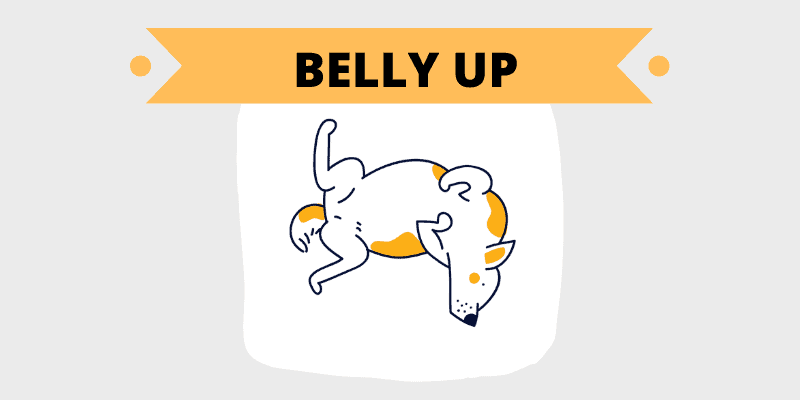
Belly up dogs are those who sleep – of course – with their belly up in the air! These guys love to roll on their back and nap the day away.
For these dogs, make sure that the bed you select can provide plenty of support for your pooch’s spine.
Dogs often use this position to cool off in the summer – you may see dogs adopt this position as the weather changes.
We suggest a memory foam dog bed with plenty of support foam, or a hammock dog bed (which helps keep canines cool during those hot summer days).
Position #4: Sidewinder
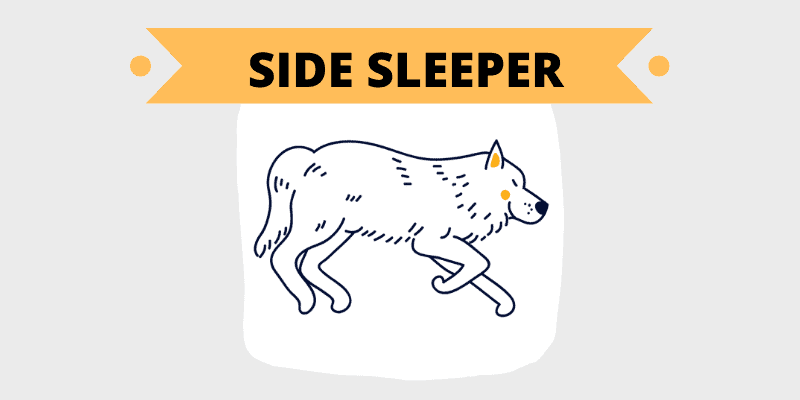
Sleeping on the side is probably one of the most common dog sleeping positions. These pooches can plop down pretty much anywhere and be happy.
Nearly any bed will work for a sidewinder. If your dog likes to sleep against objects, we’d suggest a bolster dog bed with raised edges for your pup to lean against.
Types of Dog Bed Fill
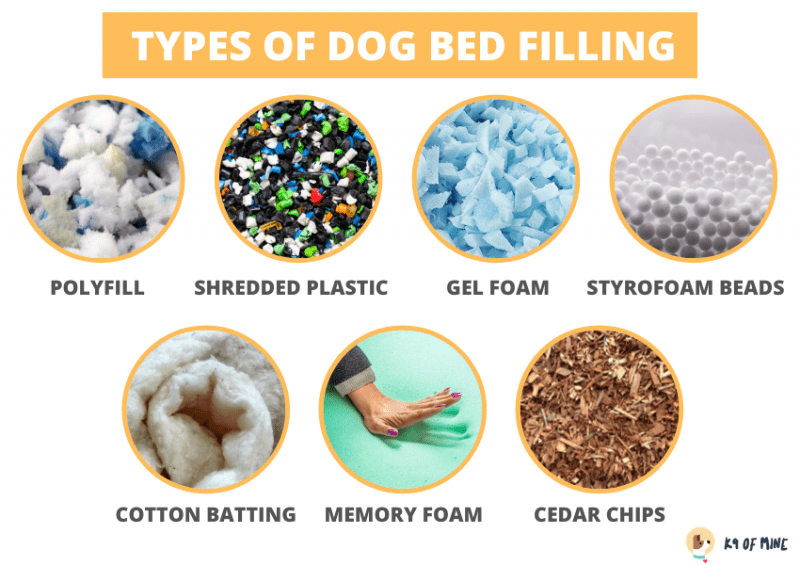
You may be asking yourself – what are dog beds made out of anyway? Well, dog beds come with a few different types of filling:
- Polyester Filling. Known as polyfill for short, this material is soft, fluffy shredded polyester. Most canines find it quite cozy, but it won’t provide as much comfort as memory foam.
- Recycled Materials. Some beds are made from recycled soda bottles and other shredded plastics.
- Gel Foam. Gel foam is a specialized type of foam that provides some cooling properties in addition to soft comfort.
- Beads & Shredded Foam. Shredded foam and styrofoam beads tend to be of lesser quality than solid layers of memory foam, but they can still provide a decent amount of comfort for your pooch (but will be lacking in support).
- Cotton Batting. Cotton batting is a common filler for dog beds, but it’s quite cheap. Cotton batting won’t hold its shape and will get lumpy over time. It’s not generally recommended, but if you love a bed’s design, you can always remove cotton batting and replace it with better materials.
- Memory Foam Layers. Memory foam layers consist of thick chunks of whole foam. Look for mixed layers of support and memory foam for the best combination of comfort and support.
- Cedar Chips. As mentioned above, cedar chip dog beds aren’t terribly comfortable, but they can be helpful for combating especially stinky canines.
Can’t My Dog Just Sleep With Me?
While there are few things on this earth better than snuggling with your pooch, we still don’t recommend sharing a nightly bed. At least not on a regular basis!
One Mayo Clinic sleep study found that many pet owners who suffered from sleep issues had their pets sleep with them in their beds every night.
While correlation doesn’t equal causation, it’s a pretty safe bet that your dog’s movements and activity will be waking you up in the night (even if you don’t remember it happening).
Still Not Sure? Ask Your Vet
Your vet will probably be quite helpful in selecting the perfect dog bed for your pooch – after all, your vet will be aware of any unique health needs your dog may have, and can point you in the right direction.
How to Introduce My Dog to a New Bed
Some dogs may take some time to get adjusted to their new bed. If your dog doesn’t seem so sure of his new hangout spot, there are a few things you can do to encourage him to get cuddled up.
Try putting other things your dog likes and know are his – like toys and bones – on his bed.
Put some treats on the dog bed or try cuddling with your canine on his bed. Show your dog that this is indeed his new bed, all his own!
Benefits of Dog Beds
- Helps Aid In Positioning Your Dog. Having a dog bed can also make moving your dog around a bit easier. Imagine company from out of town is visiting, but the youngest child is nervous around dogs. Repositioning your dog’s bed upstairs or in a side room lets your dog claim a different space as his cozy spot and can ease tense household situations.
- Keeps Dogs Off the Furniture. Giving your dog his own hangout spot means he’ll be less likely to hop up on the furniture, making cleaning time a bit easier.
- Better For Joints. Dog Beds also help your pooch’s joints by preventing him from needing to constantly jump on and off a raised couch all day.
- Good For Homes with Pet Allergies. Keeping your dog in one specific sleeping area helps reduce the movement of dander around your home and can keep those pet allergens away from the noses of those who are allergic.
What’s your dog’s favorite bed? What made you choose that style of dog bed? Share your thoughts in the comments!
